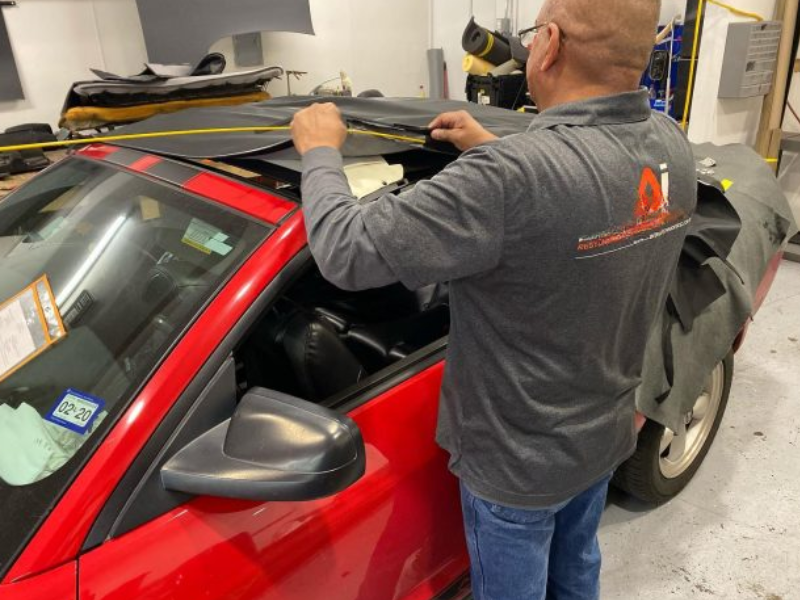Last Updated on October 6, 2023 by Matthew Lloyd
Cleaning your radiator fins is integral to regular vehicle maintenance and can help keep your car running smoothly. Cleaning the radiator fins can be done with various tools, such as compressed air, a vacuum cleaner, or even a soft-bristled brush.
What Are Car Radiator Fins?

Car radiator fins are metallic strips attached to your car’s cooling system. The fins are designed to increase the surface area for heat transfer, with more fins allowing more efficient cooling. They work by drawing in air and dissipating it as hot air, which is blown away by the airflow when driving.
Cleaning Car Radiator Fins
What you need
- Radiator Cleaner
- Soft-Bristled Brush
- Spray Bottle
- Hose
- Gloves
Instruction

Allow The Radiator To Cool: Before cleaning the radiator fins, you must allow the car to cool down.
Wear Protective Gear: Wear protective gloves and safety glasses when cleaning the radiator fins.
Remove Debris From Radiator Fins: Use a soft-bristled brush or compressed air to remove dirt, dust, and debris from the fins. Be careful not to damage the fins with excessive force.
Spray Cleaner: Fill a spray bottle with a radiator cleaner and lightly mist the fins. This will help dissolve dirt, grime, and grease accumulated on the fins.
Clean Radiator With A Brush: Using a soft-bristled brush, gently scrub the fins to remove any remaining dirt or debris. Be careful not to damage the fins while brushing them.
Rinse: Use a hose to rinse any remaining cleaner and residue from the radiator fins. Make sure the cleaner has been washed off before drying.
Air Dry: Allow the radiator fins to air dry before using the car. Ensure that no moisture is left behind.
Reinstall Radiator: Finally, reinstall the radiator and ensure all connections are secure.
How To Keep Your Radiator In Top Condition?

- Regularly check the radiator fins for any signs of dirt or debris.
- Perform service and maintenance on your car as recommended by the manufacturer.
- Check fluid levels in the cooling system and top off if necessary.
- Secure the radiator cap firmly in place.
- Flush your radiator and oil change at the same time
- Make sure to replace any hoses that appear worn or damaged.
- Have a professional inspect your radiator annually for potential problems.
Consequences Of Having Dirty Car Radiator Fins
- The engine’s reduced cooling efficiency can lead to overheating and other problems.
- Blockage in the radiator fins, resulting in inefficient heat transfer.
- Poor airflow across the radiator leads to decreased performance.
- Due to dirt, dust, and debris, the potential buildup of rust and corrosion over time.
Precaution
- Be careful not to bend or damage the fins while cleaning.
- Make sure all cleaner has been rinsed off before drying.
- Inspect the radiator for any signs of corrosion or damage before use.
- Always wear protective gloves and safety glasses when working in the car.
FAQs
What Does It Mean To Flush A Radiator?

A radiator flush is a process of cleaning the cooling system by removing any buildup and contaminants. This helps maintain optimal cooling efficiency and prevent damage caused by rust, scale, or foam damage.
What Are The Signs That My Radiator Needs Flushing?

Signs that your radiator needs flushing include an increase in engine temperature, slow heating, and a decrease in radiator performance.
What Happens If I Don’t Flush My Radiator?

If you neglect to flush your radiator, it can lead to damage or even failure of the radiator, resulting in costly repairs or replacement. It is best to flush your radiator regularly as part of routine maintenance.
Does A Radiator Give Off Dust?

Yes, a radiator can give off dust. The dust is created when the air passes through the radiator fins and is composed of dirt, debris, and other contaminants that accumulate in the system.
How Much Dust Does A Radiator Give Off?

The dust a radiator gives off depends on the system’s condition and how often it is cleaned. Regular cleaning and maintenance can help reduce the amount of dust given off from your radiator.
When Should I Flush My Radiator?
You must flush your radiator every two years or 50,000 miles. This will prevent the buildup of contaminants and rust from forming in the cooling system and ensure your radiator continues to perform optimally.
Conclusion
Cleaning your car’s radiator fins can help keep it running smoothly and efficiently. You can easily clean the radiator fins in no time. Remember to be safe while working on your car. If you notice any signs of damage or corrosion, contact a professional for help.

